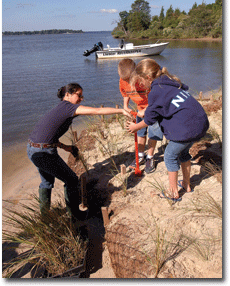How may climate change affect Maryland’s environment?
Maryland has experienced changes in its climate over the last century and on the whole, the State is experiencing warmer winters and summers, wetter autumns and springs, and drier summers.
What is Maryland doing?
 In the future, it is expected that climate change will affect Maryland in a variety of ways. More obvious impacts could include an increased risk for extreme events such as drought, storms, flooding, and forest fires; more heat-related stress; the spread of existing or new vector-born disease; and increased erosion and inundation of low-lying areas along the State’s shoreline and coast. Adaptation, together with mitigation, is necessary to address climate change.
In the future, it is expected that climate change will affect Maryland in a variety of ways. More obvious impacts could include an increased risk for extreme events such as drought, storms, flooding, and forest fires; more heat-related stress; the spread of existing or new vector-born disease; and increased erosion and inundation of low-lying areas along the State’s shoreline and coast. Adaptation, together with mitigation, is necessary to address climate change.
 Chapter 8 of the Greenhouse Gas Reduction Plan details the many adaptation strategies being taken by the State of Maryland.
Chapter 8 of the Greenhouse Gas Reduction Plan details the many adaptation strategies being taken by the State of Maryland.
 What is the department doing?
What is the department doing?
The Department of Natural Resources has the lead role among State agencies in advancing the scientific understanding of Maryland’s vulnerability to climate change, and in advocating for sound planning to avoid or minimize the anticipated impacts.  Department of Natural Resources Policy: Building Resilience to Climate Change guides the Department’s investments in and management of land, resources and assets to better understand, mitigate and adapt to climate change. The policy establishes practices and procedures related to new land investments, facility siting and design, habitat restoration, government operations, research and monitoring, resource planning and advocacy.
Department of Natural Resources Policy: Building Resilience to Climate Change guides the Department’s investments in and management of land, resources and assets to better understand, mitigate and adapt to climate change. The policy establishes practices and procedures related to new land investments, facility siting and design, habitat restoration, government operations, research and monitoring, resource planning and advocacy.
What you can do?
Small lifestyle changes we each can take accumulate significantly to reducing air pollution that causes climate change and preparing for its impact. Simple things like conserving energy at home and work; carpooling, walking or bicycling to work; and planting a tree make a real difference in our neighborhoods for both people and wildlife. Individuals living in the coastal zone should utilize “living shoreline” practices that combine marsh plantings with sills, groin fields or breakwaters to remedy shore erosion problems. If you are building or rebuilding in the coastal floodplain, elevate your home or business 2 or more feet above the 100-year base flood elevation. Families should also develop a personal emergency response plan in preparation of hurricanes, heat waves and vector-borne illness.
Click here for more helpful tips on what you can do to prevent climate change.